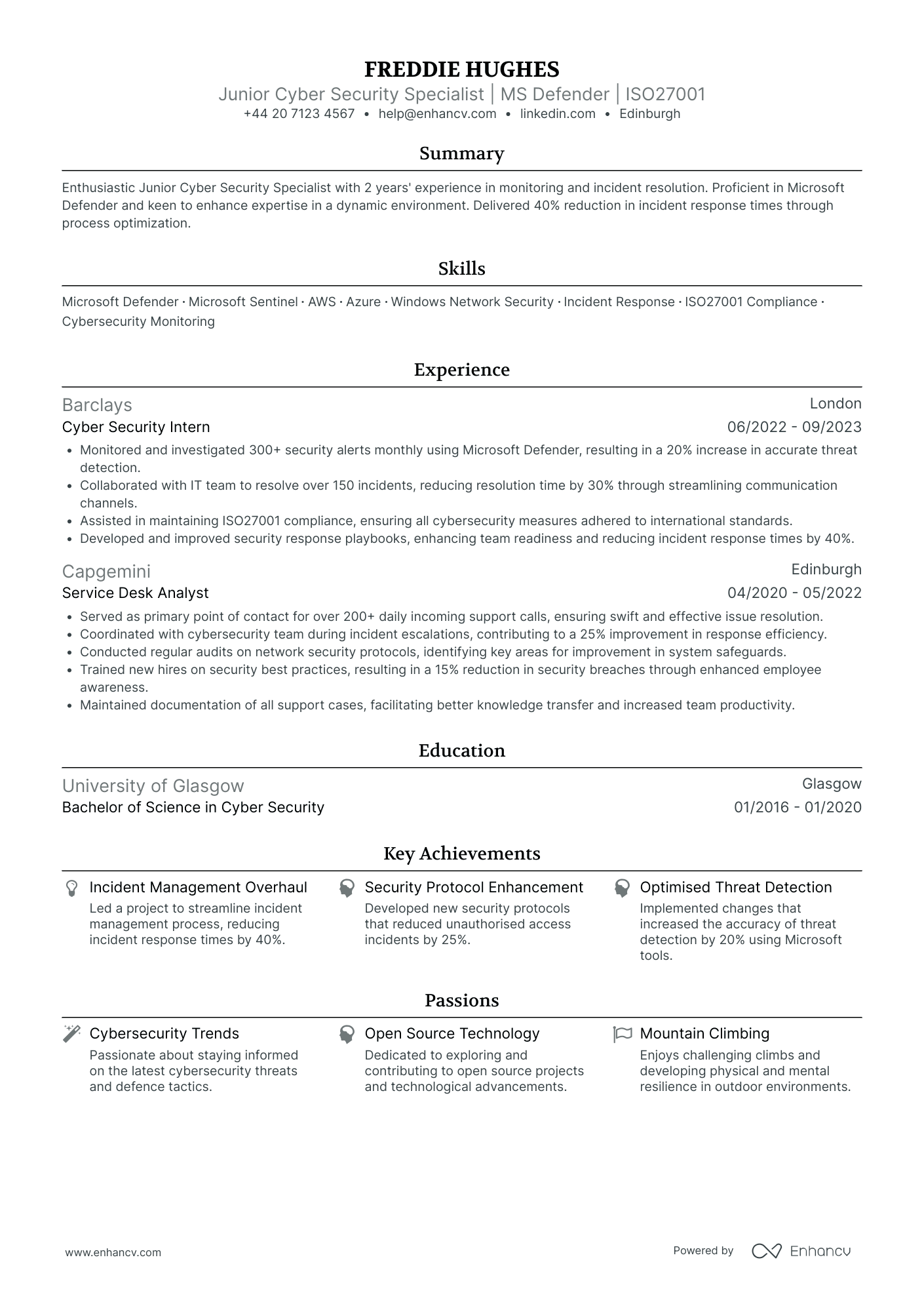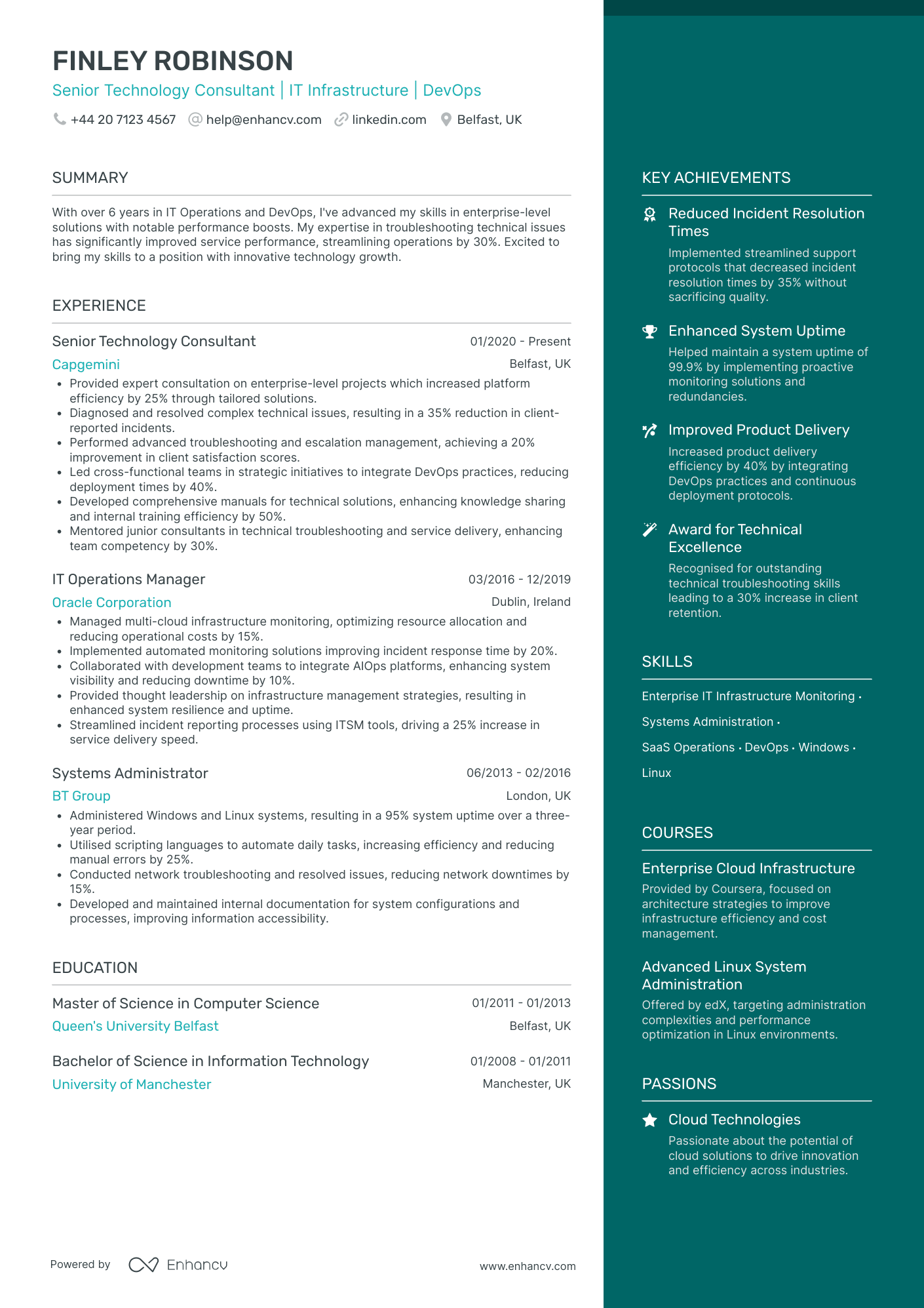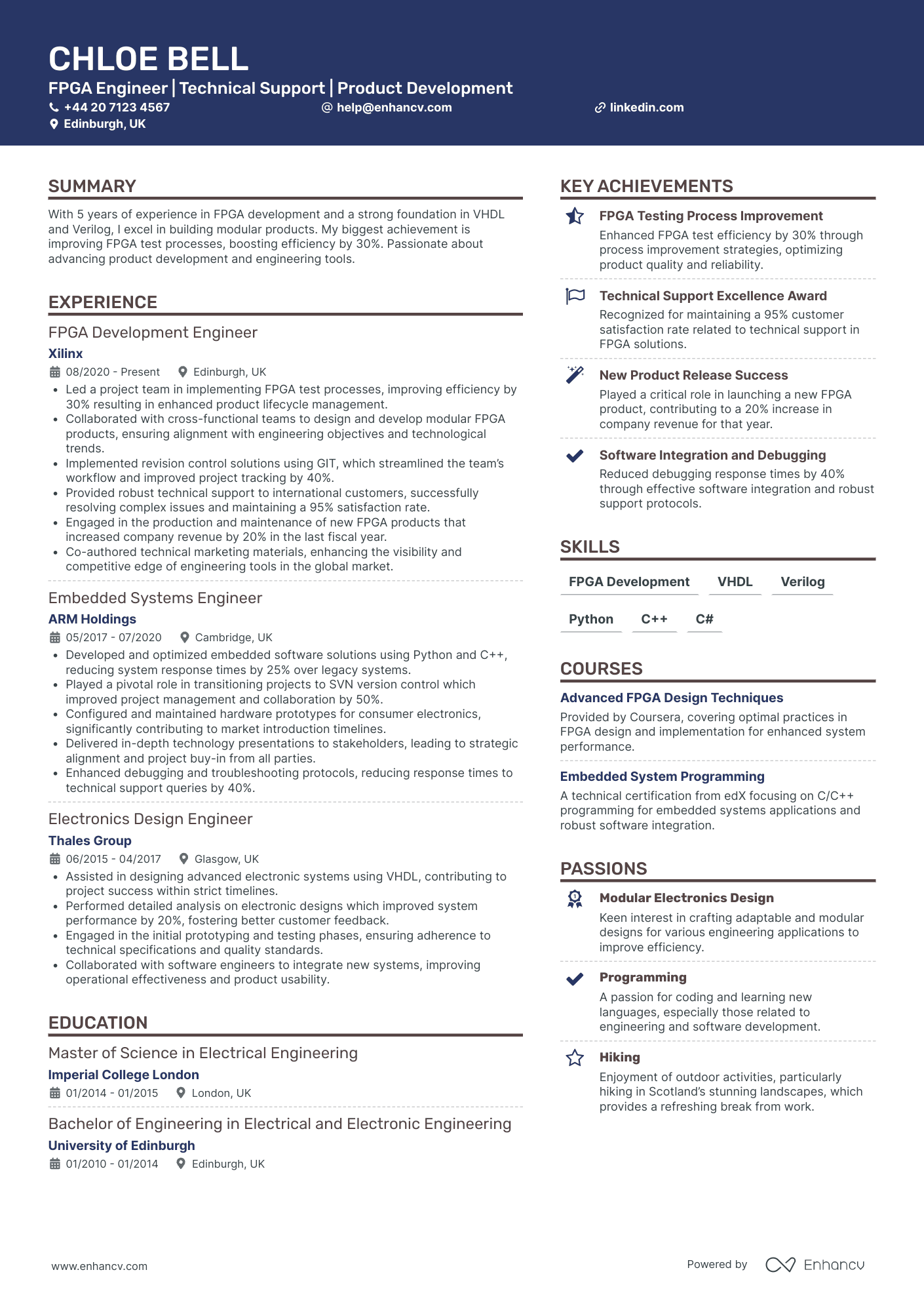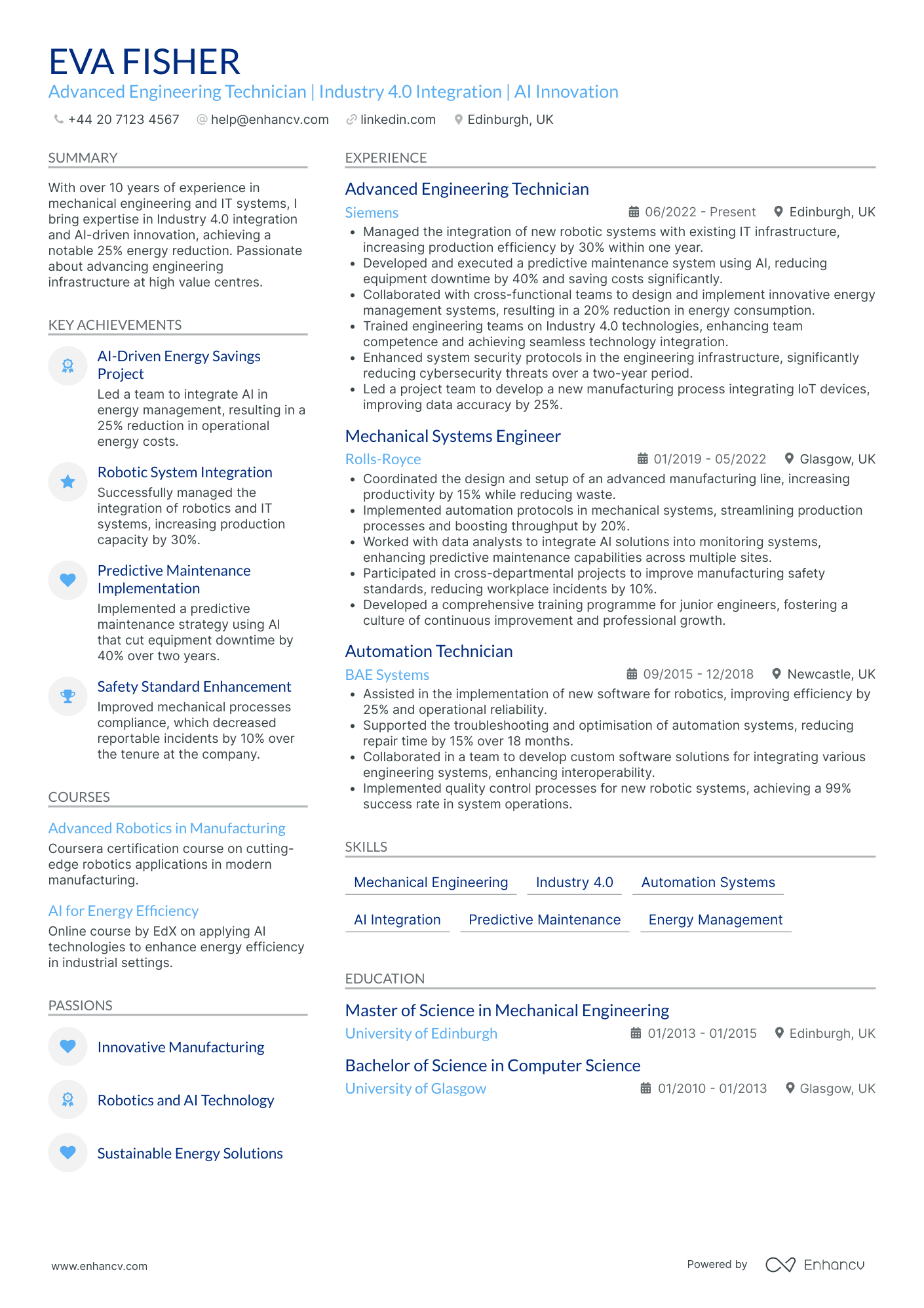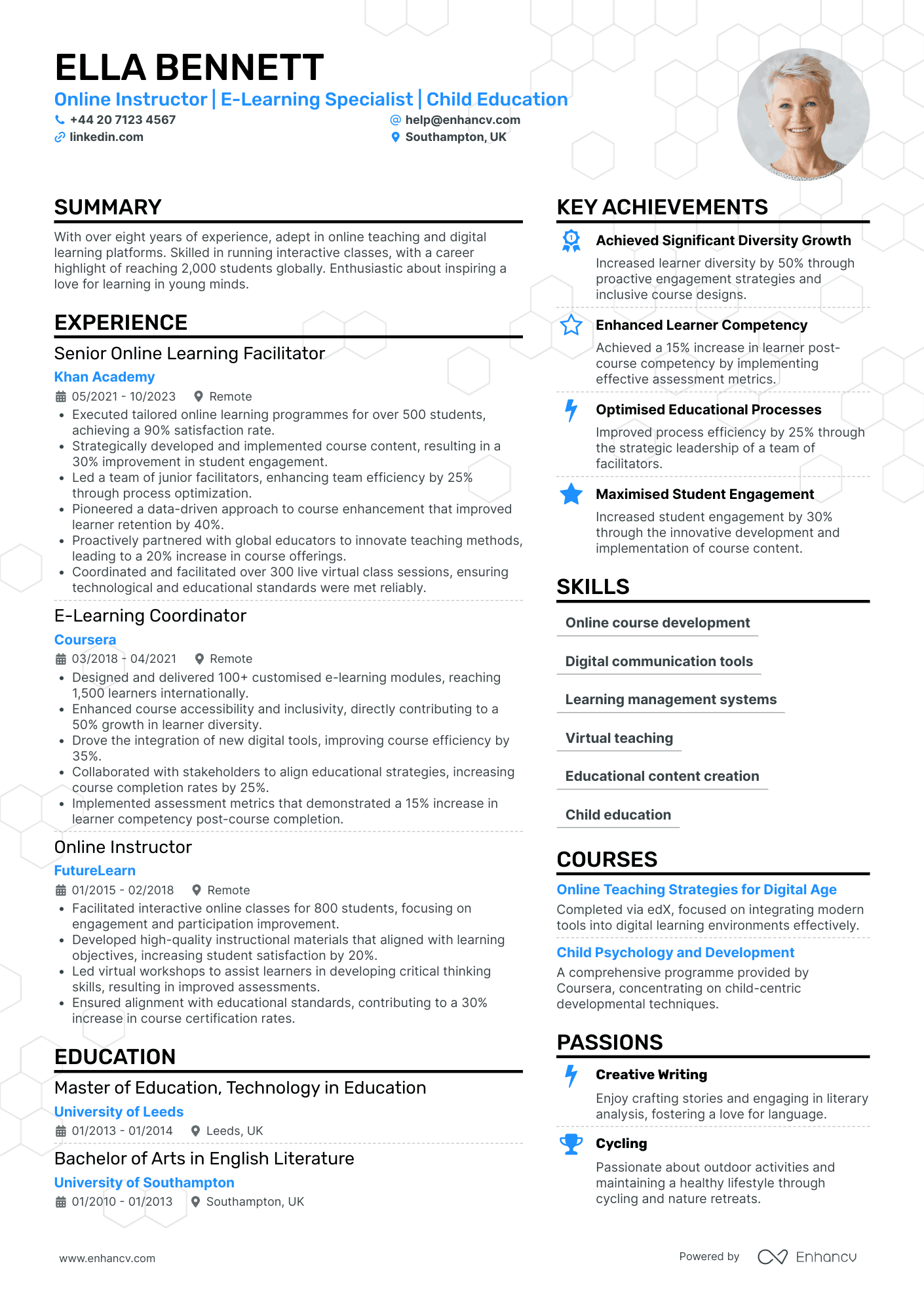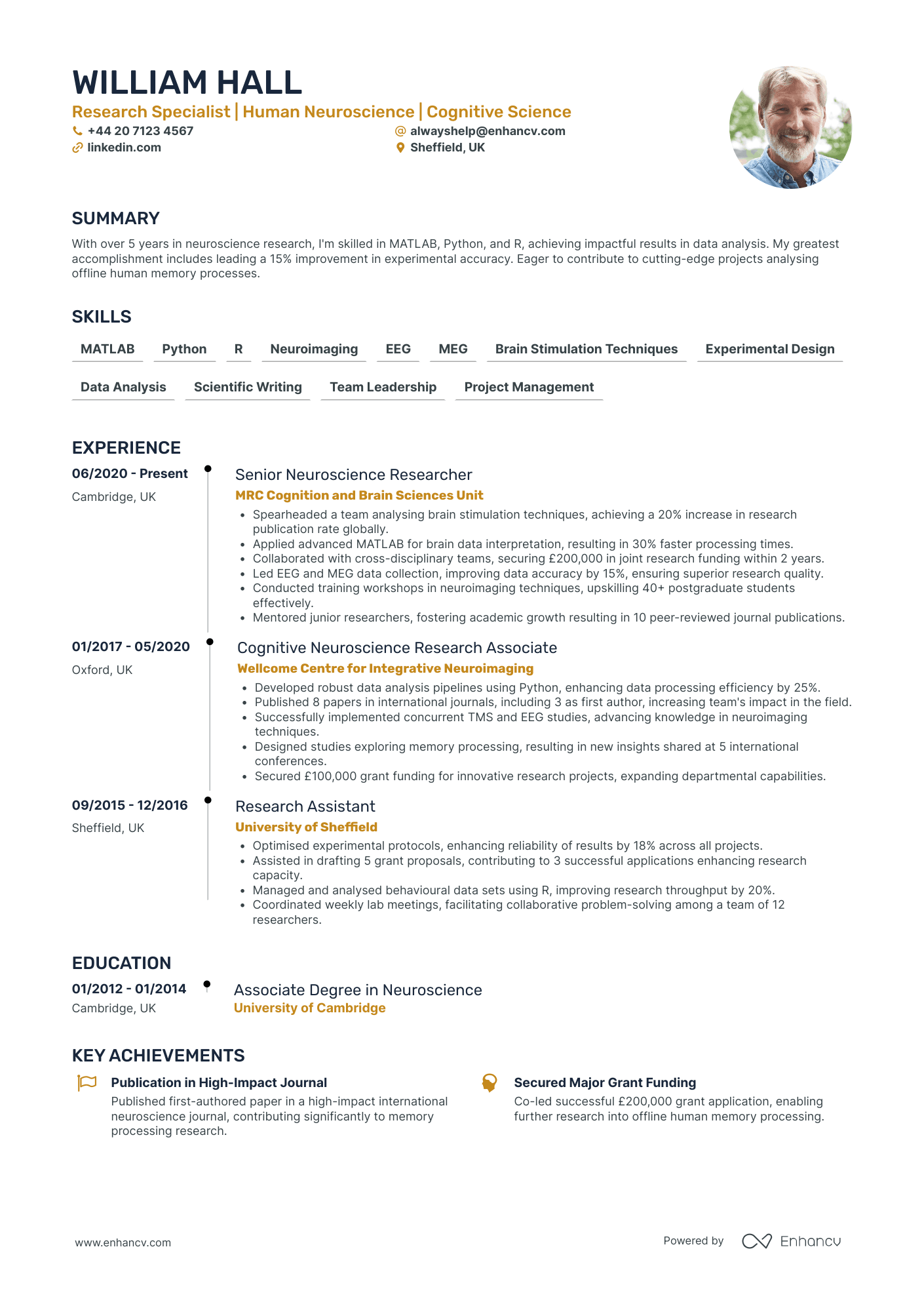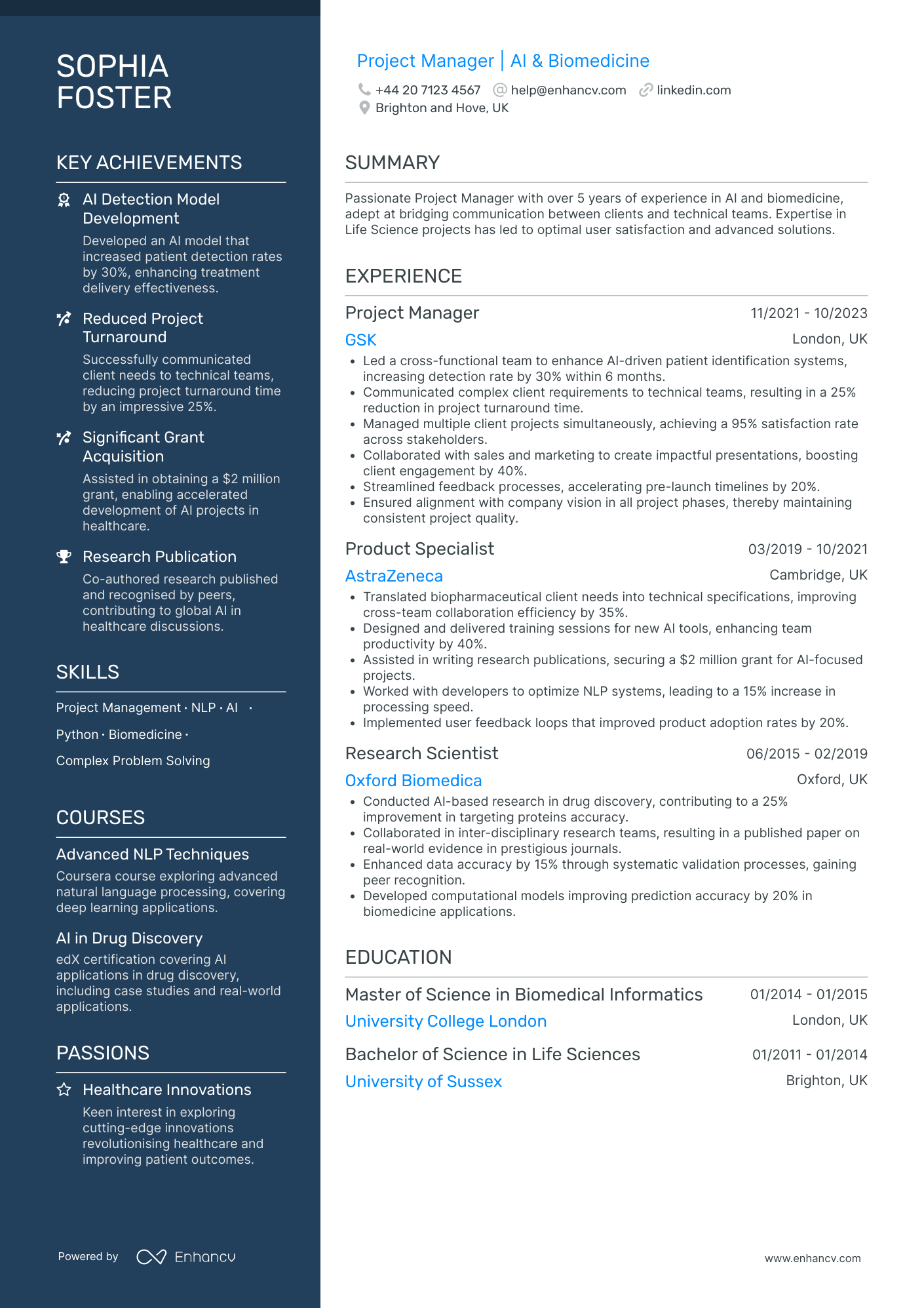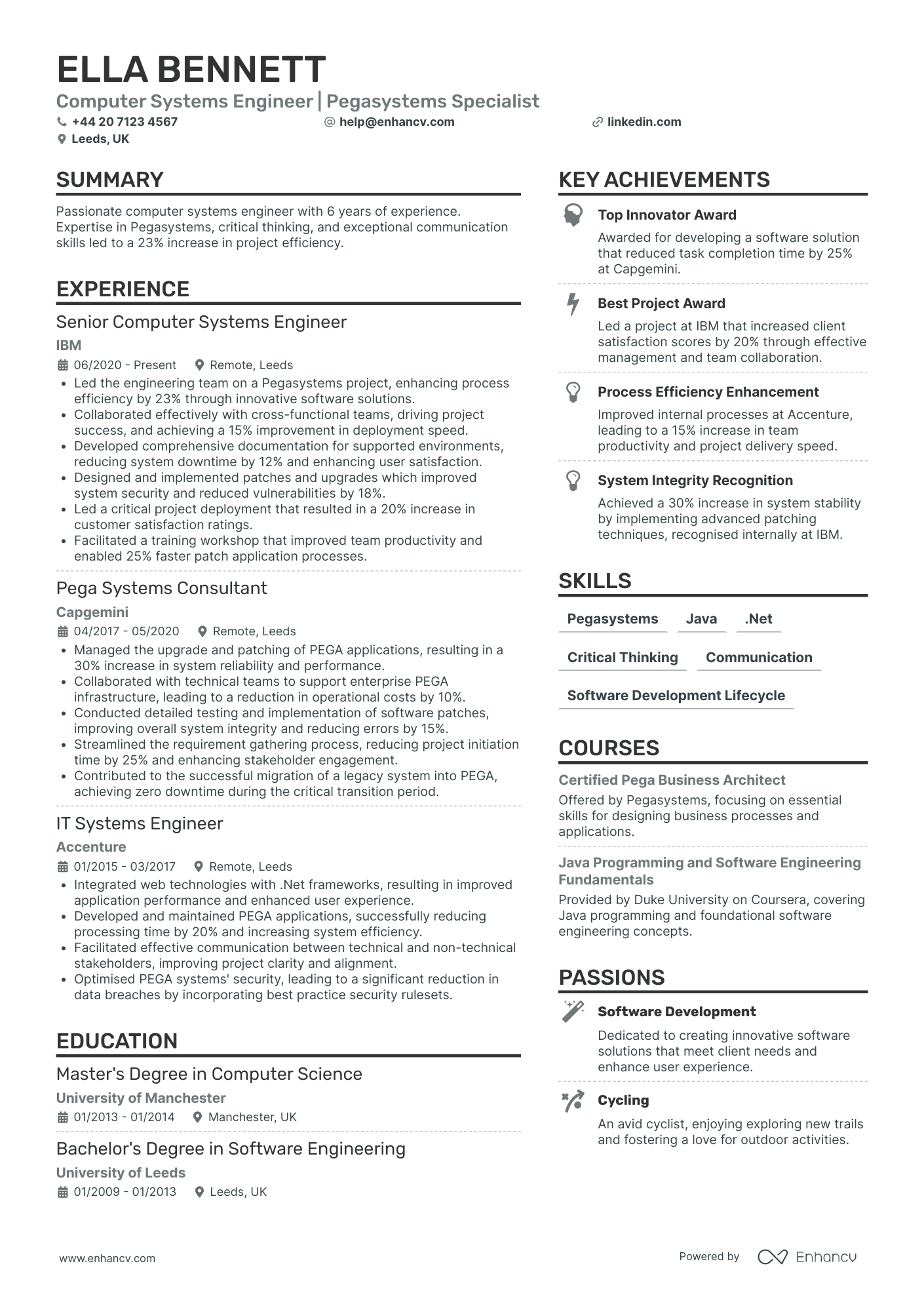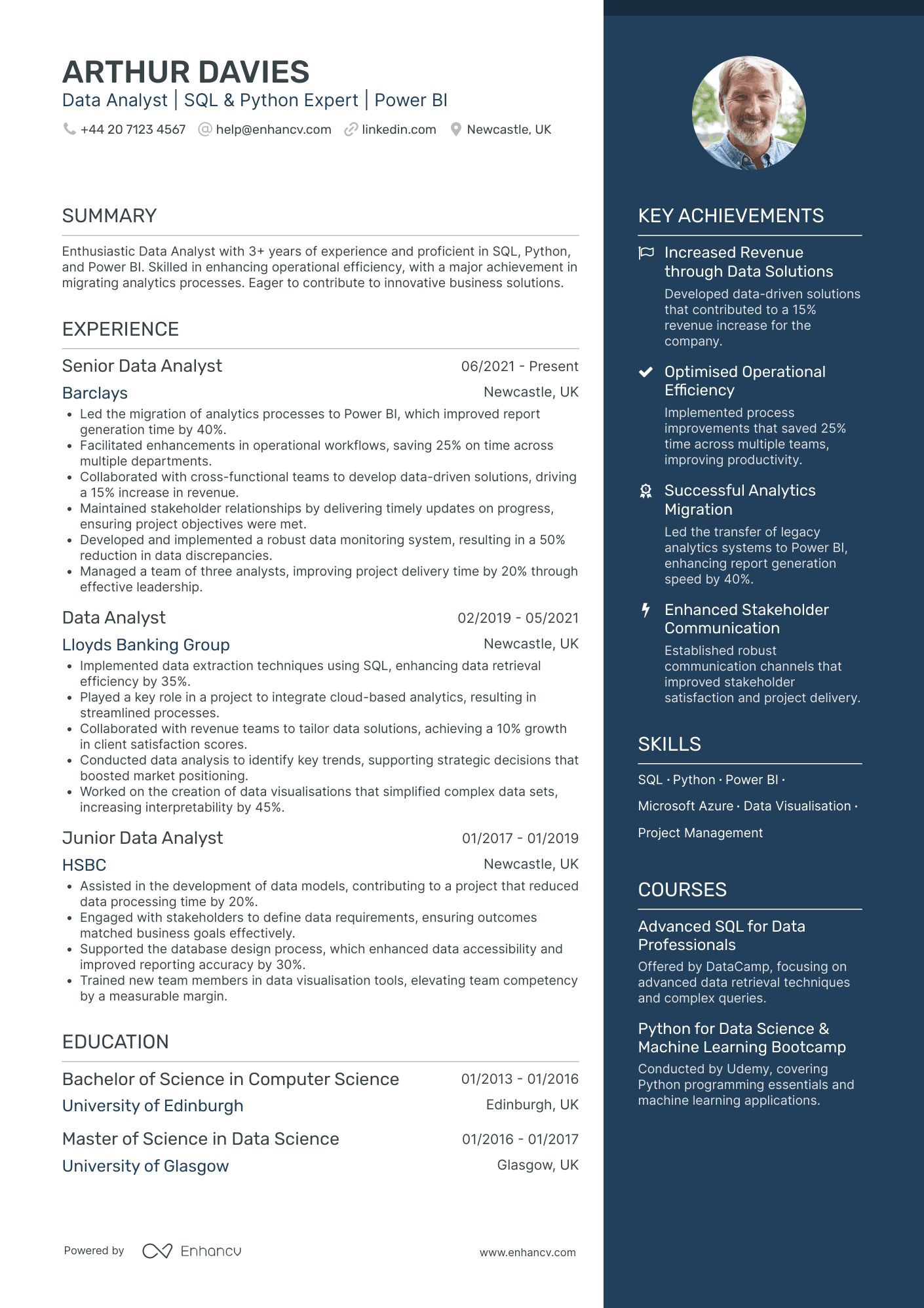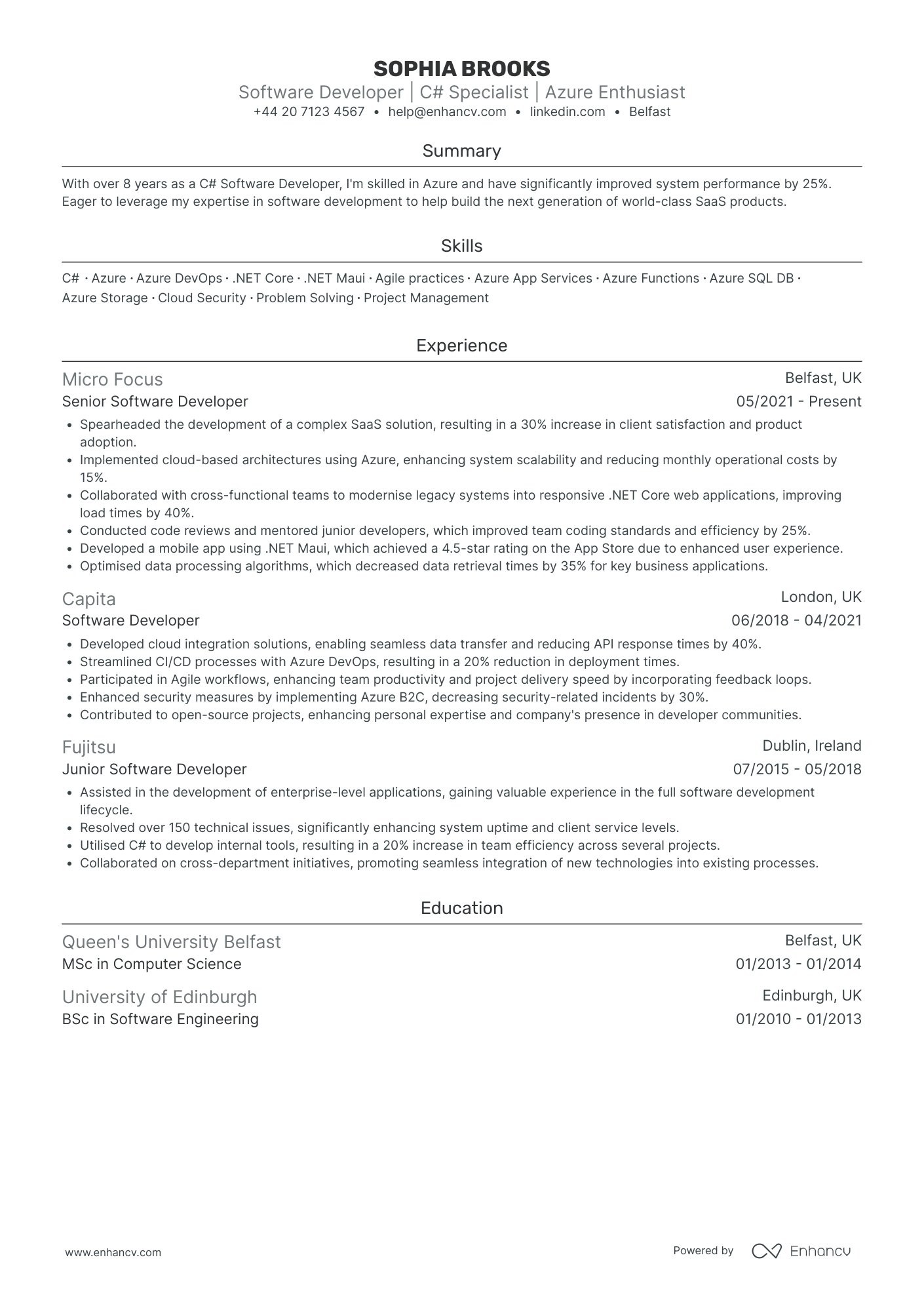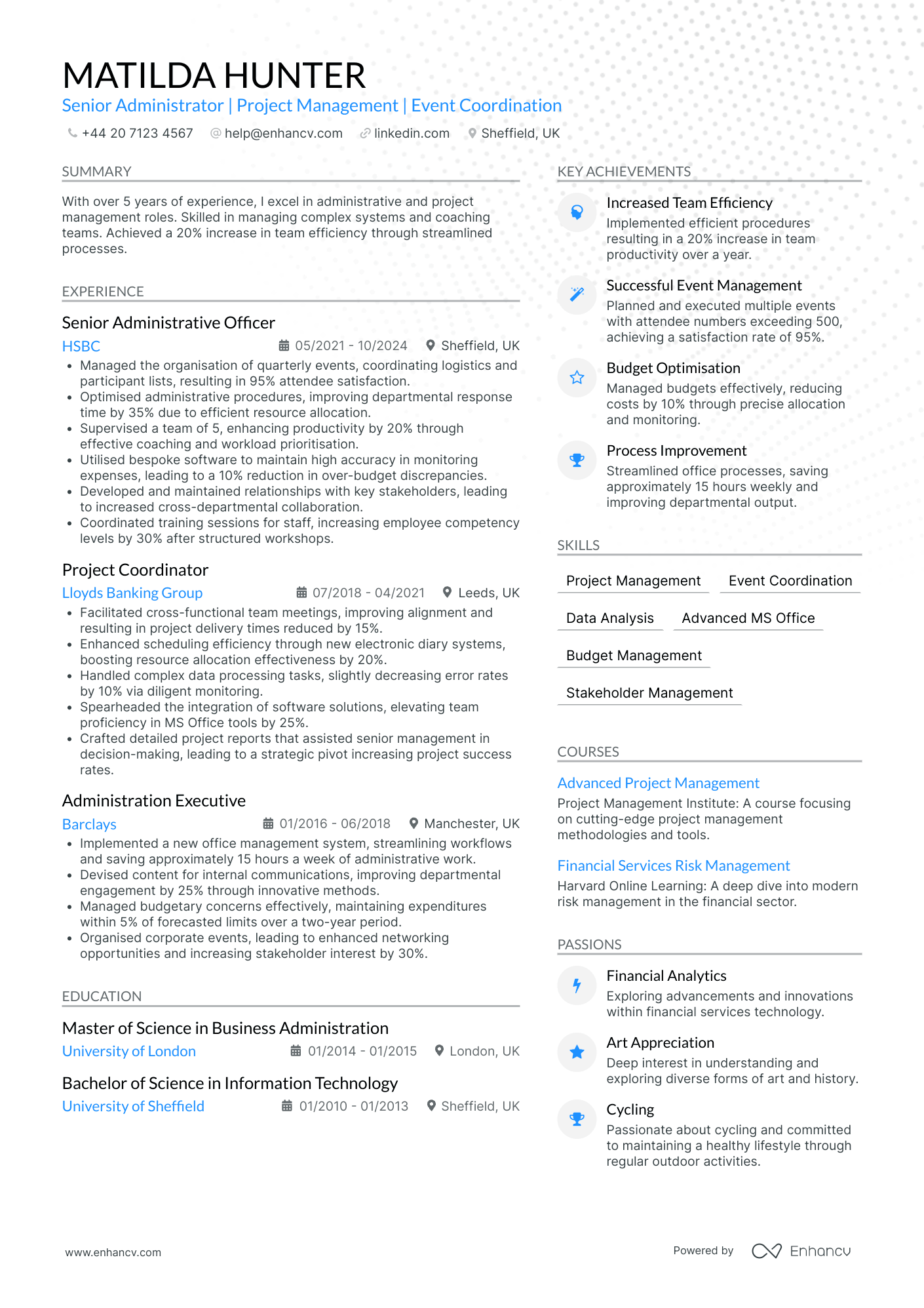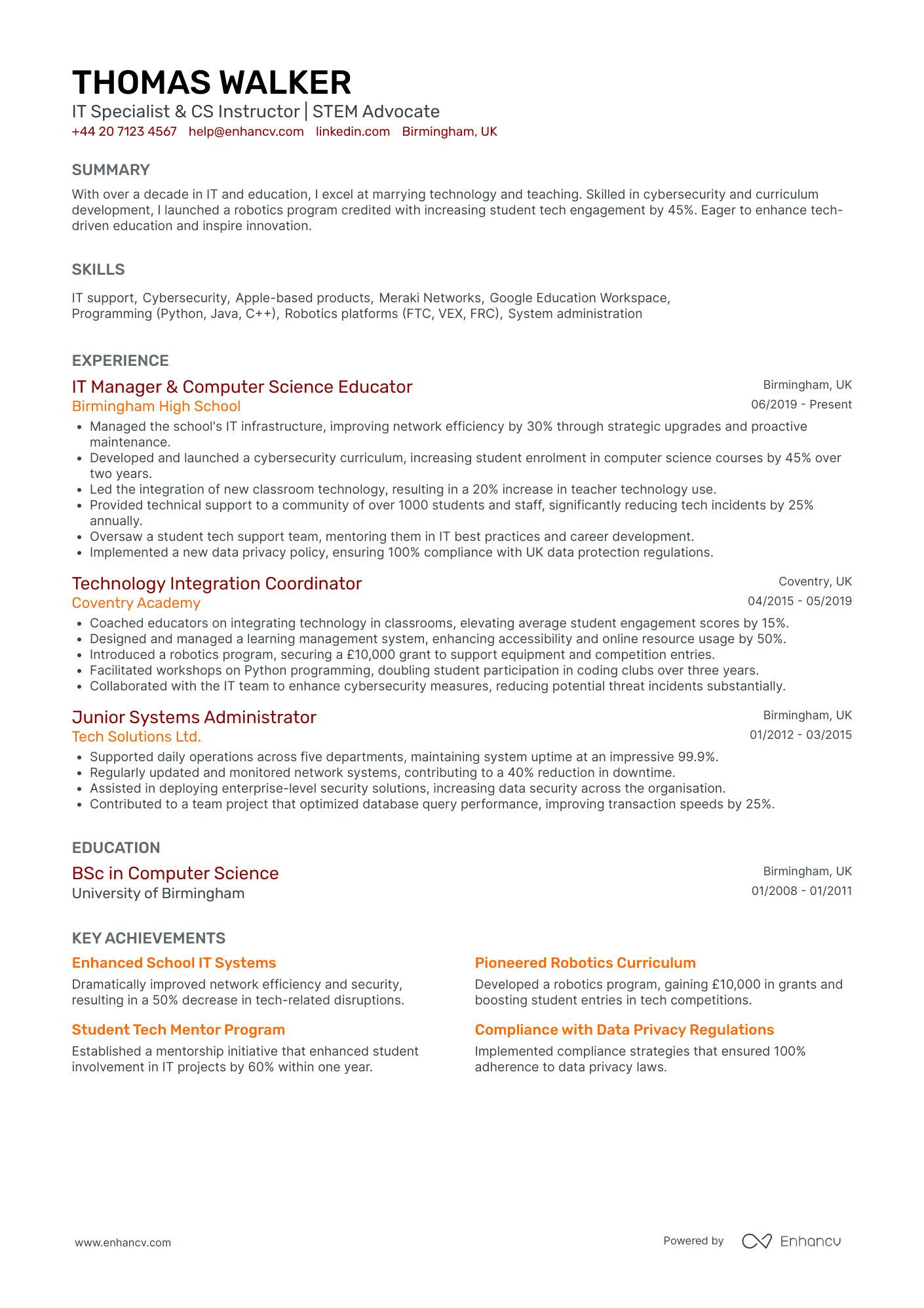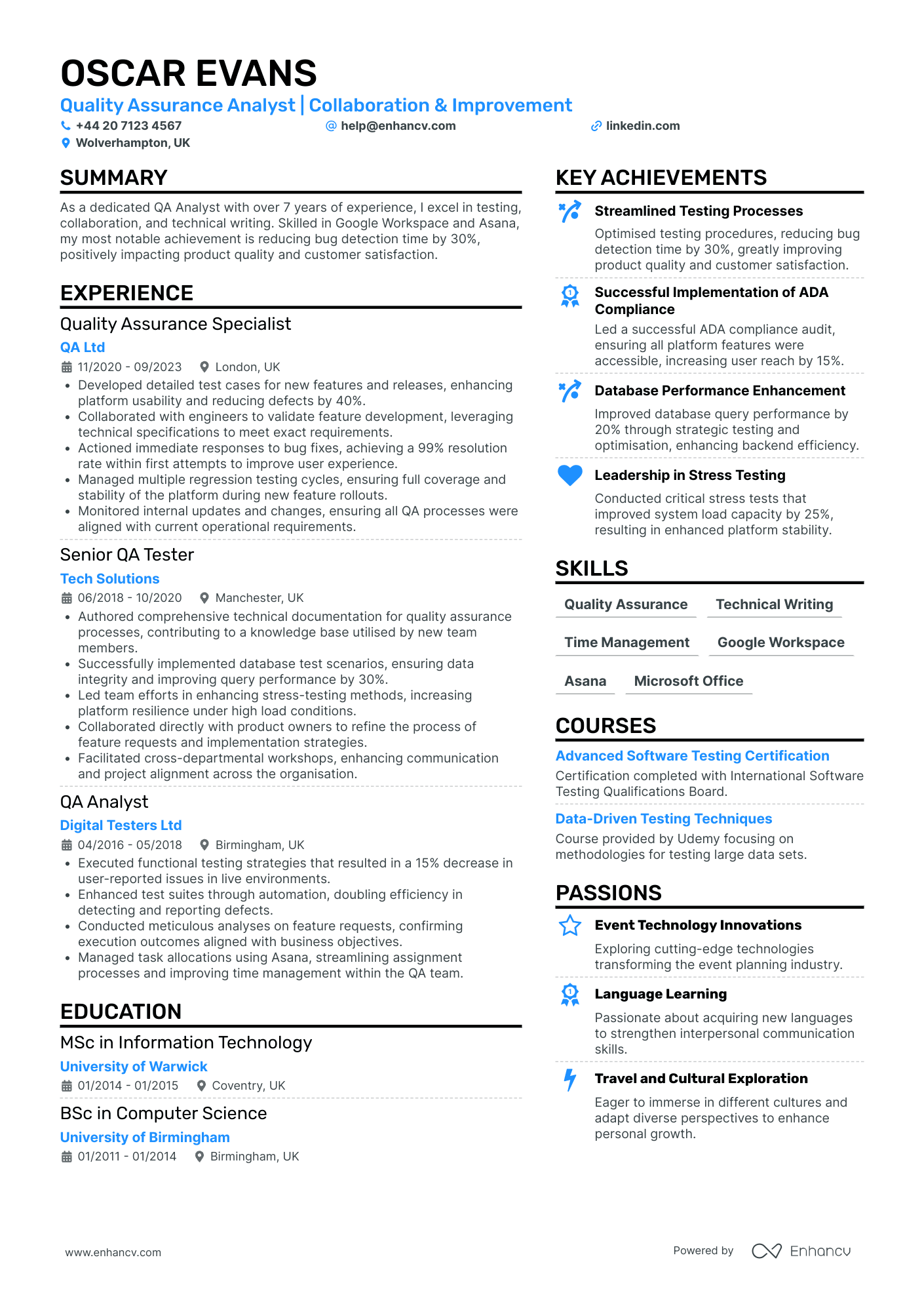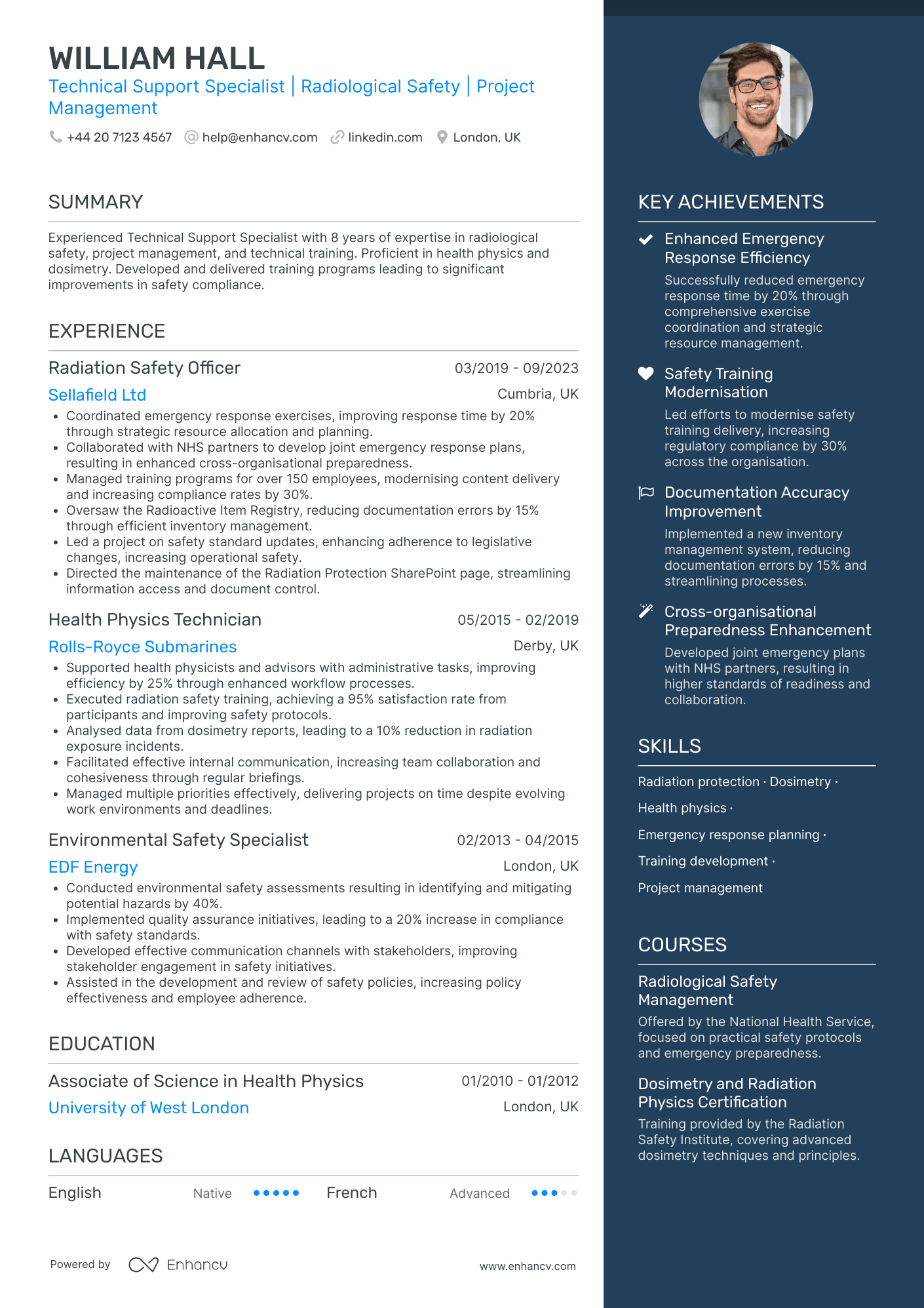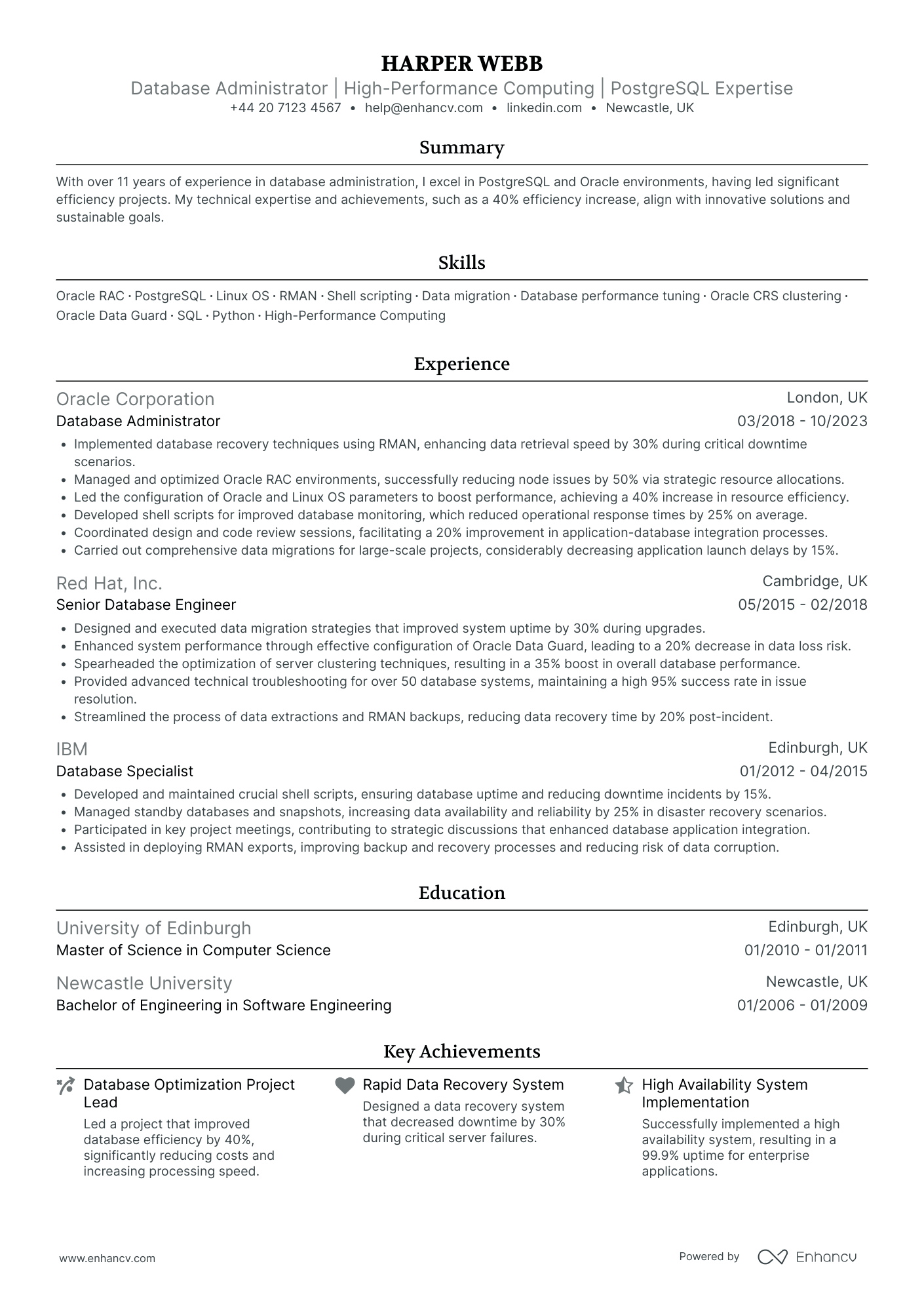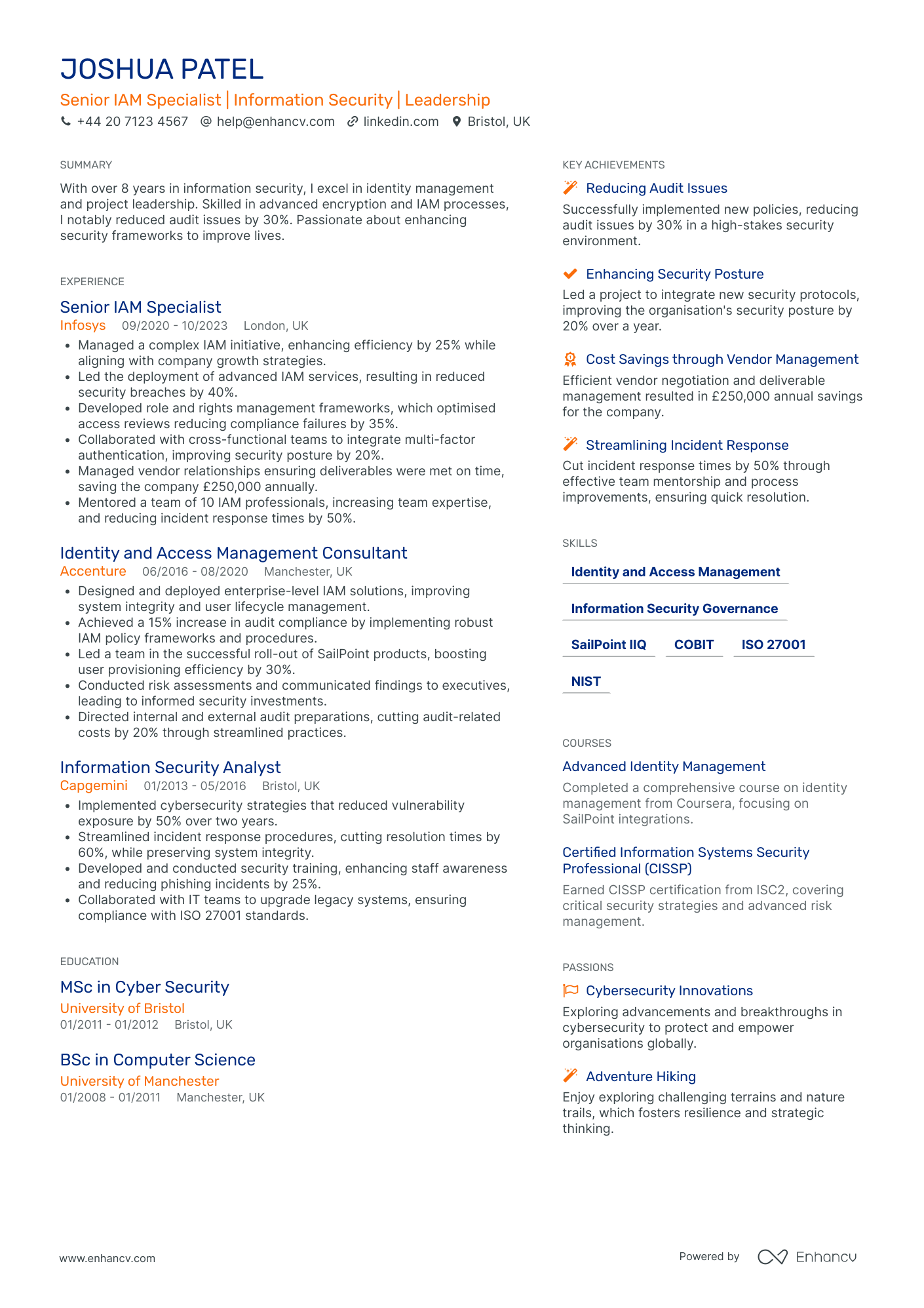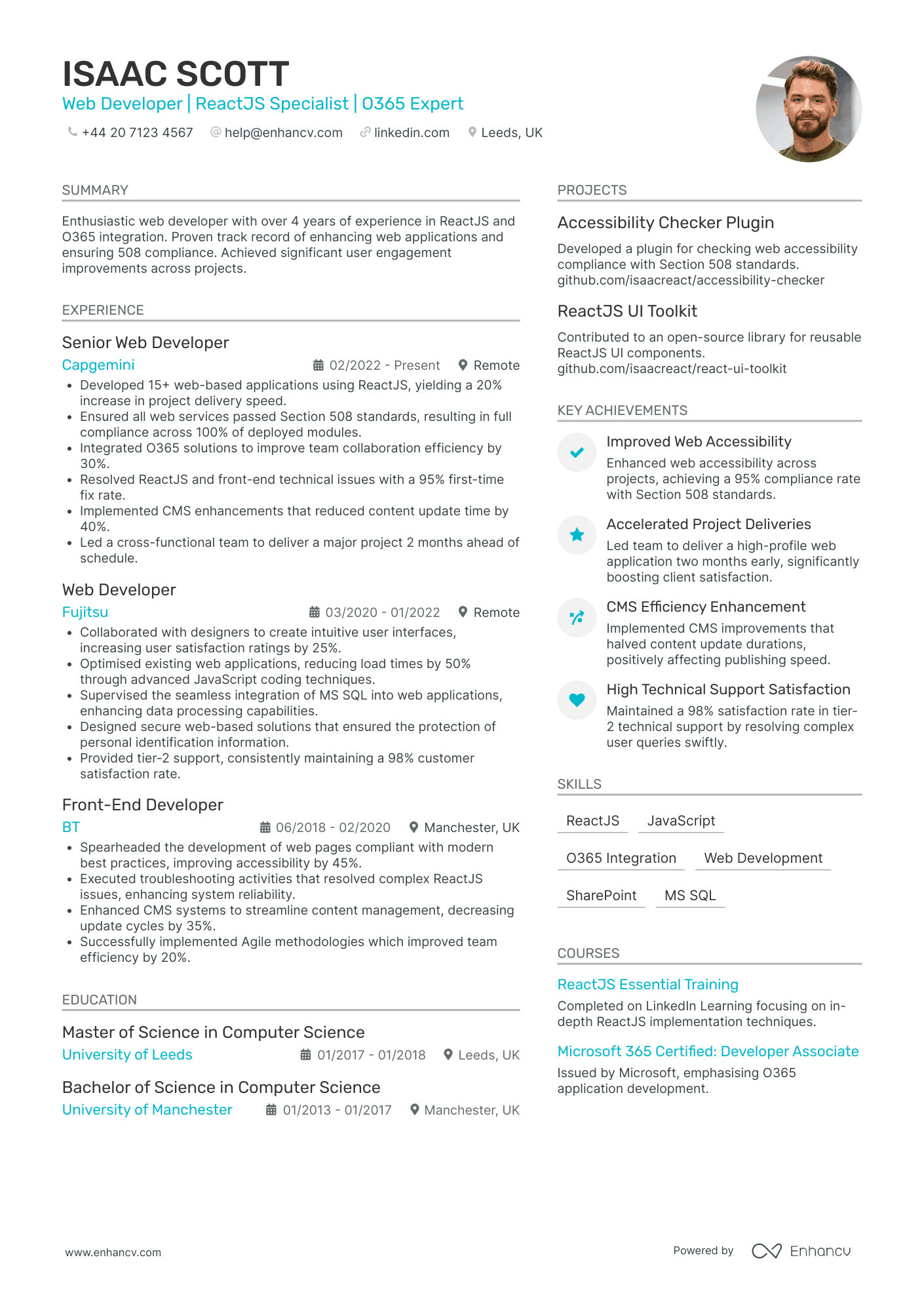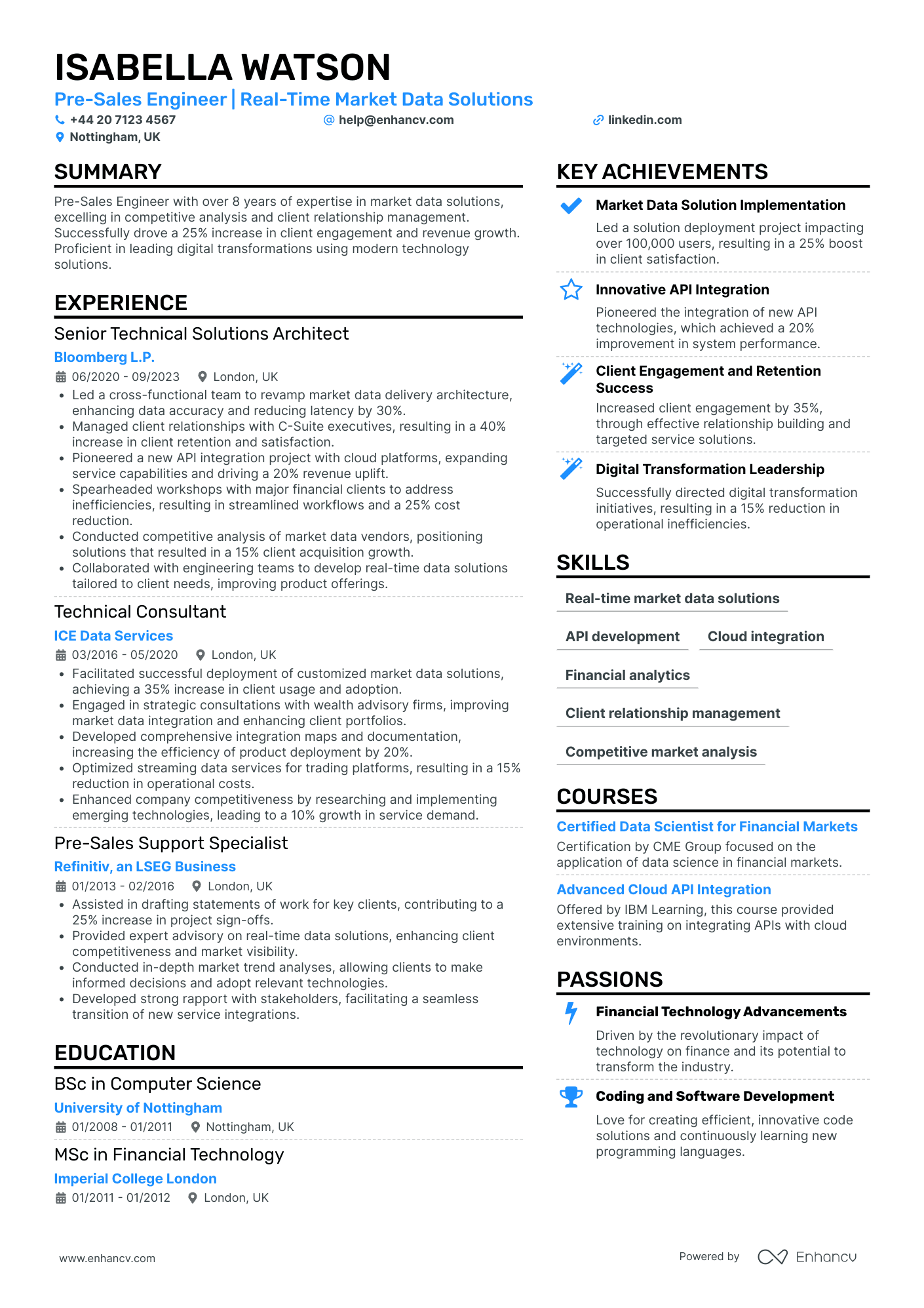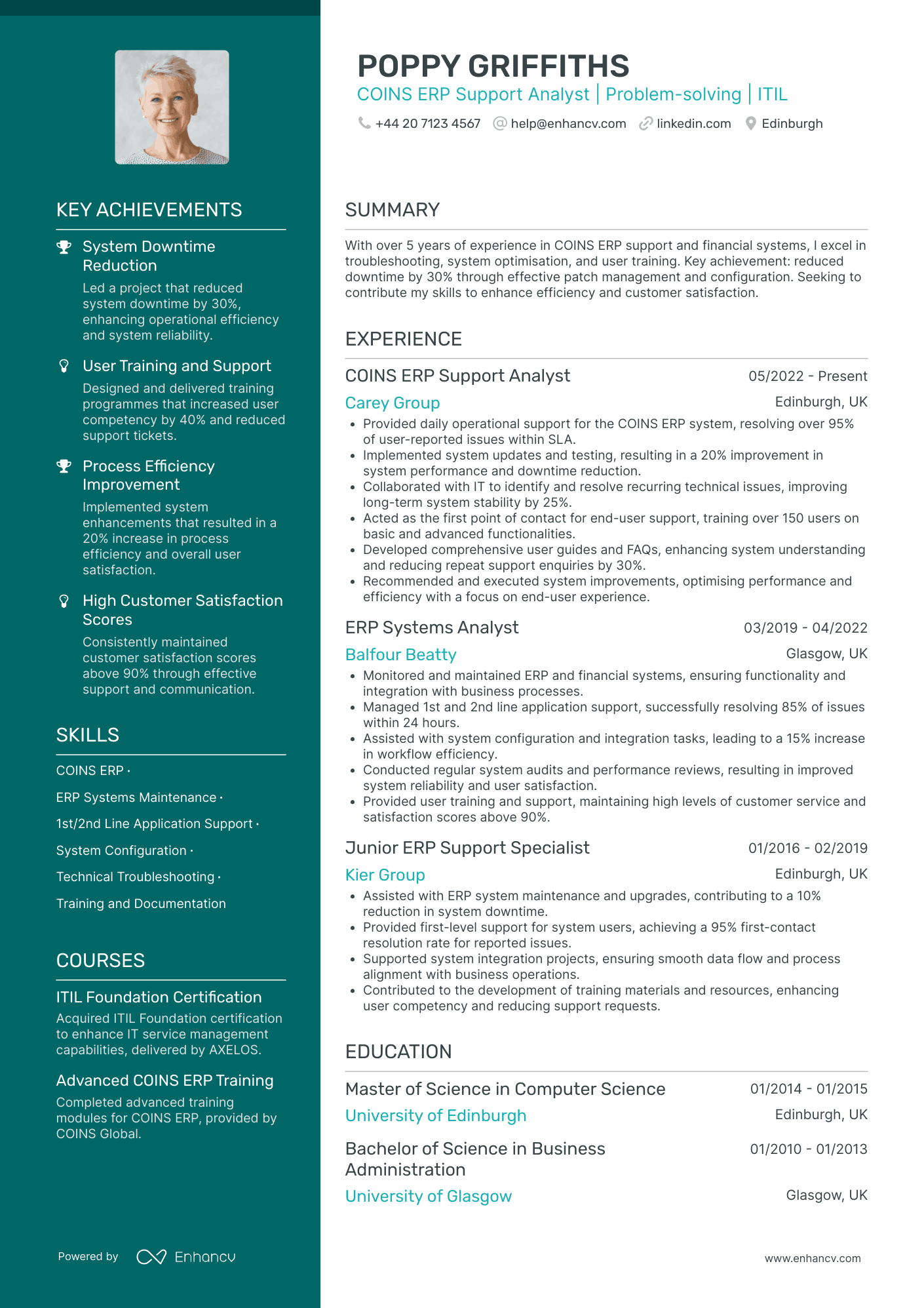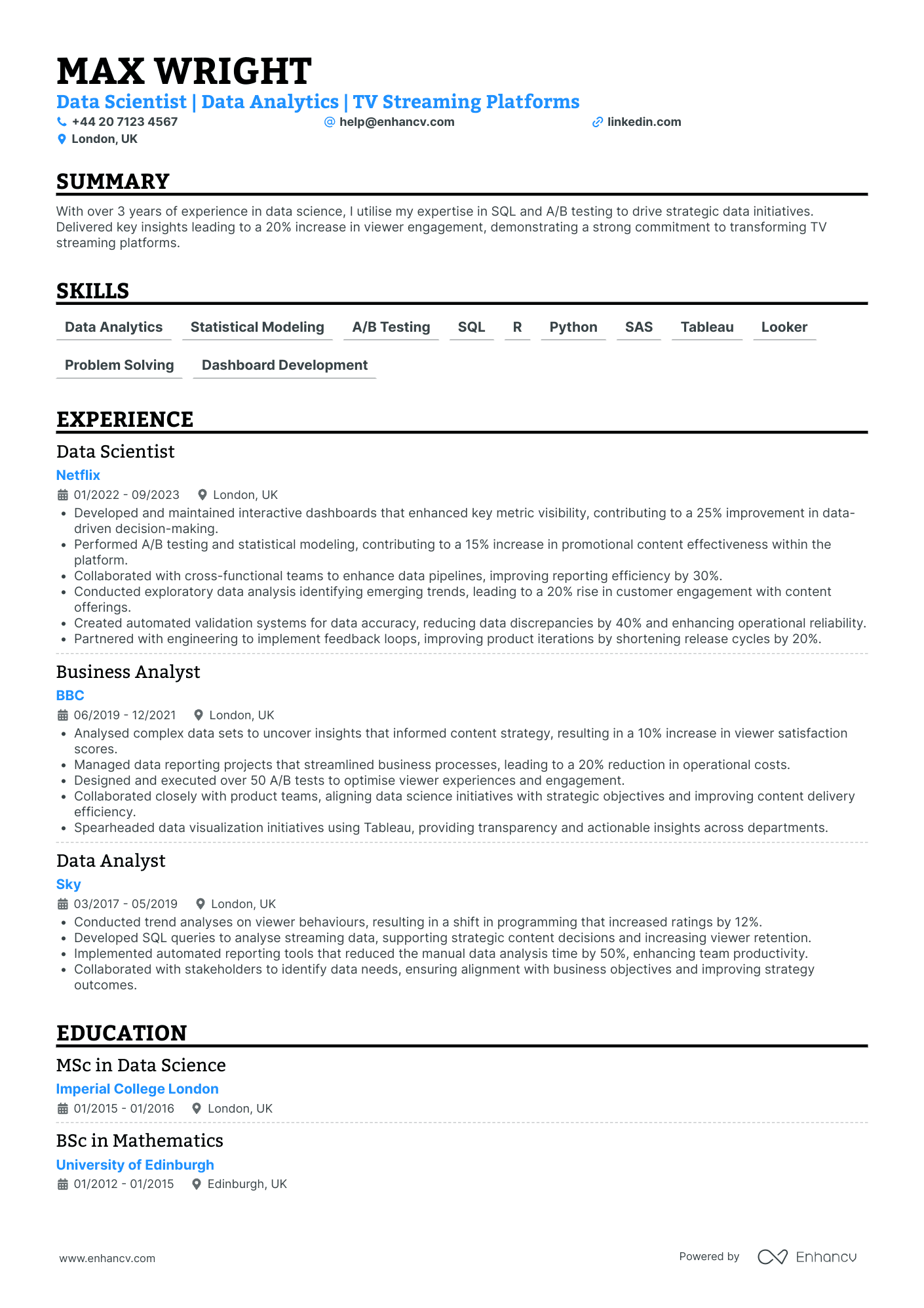Achieving the perfect balance between technical expertise and soft skills is a significant CV challenge in the computer science field. Our guide offers tailored advice to help you highlight your programming prowess while also showcasing your collaborative strengths and problem-solving abilities.
- Design and format your professional computer science CV;
- Curate your key contact information, skills, and achievements throughout your CV sections;
- Ensure your profile stays competitive by studying other industry-leading computer science CVs;
- Create a great CV even if you happen to have less professional experience, or switching fields.
When writing your computer science CV, you may need plenty of insights from hiring managers. We have prepared industry-leading advice in the form of our relevant CV guides.
Resume examples for computer science
By Experience
Junior Computer Science Analyst
- Strong technical foundation and tool proficiency - Freddie's CV effectively showcases his expertise in cybersecurity tools such as Microsoft Defender, AWS, and Azure. His deep understanding of these tools, combined with experience in ISO27001 compliance, sets him apart as a candidate well-versed in industry standards and technical frameworks, essential for a junior-level role aiming to grow in cybersecurity.
- Career growth from support to cybersecurity - The progression from a Service Desk Analyst to a Cyber Security Intern reflects a deliberate and strategic career trajectory. Freddie demonstrates effective application of his skills in customer interaction and issue resolution to a specialized cybersecurity context, showing adaptability and a focus on professional development within the industry.
- Significant business impact through achievements - The CV includes impactful achievements, such as leading an incident management overhaul with a 40% reduction in response times. These documented successes not only highlight Freddie's capability to drive efficiency but also underline his contributions to the companies he worked with, emphasizing real-world influence beyond mere numbers.
Senior Computer Science Consultant
- Comprehensive Career Development - Finley Robinson's CV exhibits a clear upward trajectory in his career, transitioning from Systems Administrator to Senior Technology Consultant within top-tier companies like BT Group, Oracle Corporation, and Capgemini. This rise demonstrates his consistent growth and adaptability, echoing a deepening expertise across IT infrastructure and DevOps fields.
- Technical Proficiency with Impactful Results - The CV highlights Robinson’s proficient use of industry-specific tools and methodologies like ITSM tools, AIOps platforms, and cloud platforms, leading to tangible outcomes. For example, his work led to a 35% reduction in client-reported incidents and a 40% reduction in deployment times, indicating a clear influence on operational efficiency and customer satisfaction.
- Strong Emphasis on Leadership and Mentoring - The document effectively underscores Finley's leadership abilities, highlighting his role in mentoring junior consultants and leading cross-functional teams. This not only improves team competency by 30% but also underscores his alignment with strategic organizational goals through initiatives like integrating DevOps practices.
Entry-Level Computer Science Engineer
- Outstanding Clarity and Structure - Chloe Bell's CV is meticulously organized, with clear sections that guide the reader through her background. The concise bullet points effectively convey key achievements and responsibilities, ensuring that each section highlights specific skills and experiences relevant to her role in FPGA engineering and development.
- Strong Career Progression - Chloe's career trajectory showcases a logical progression from an Electronics Design Engineer to an FPGA Development Engineer, illustrating both vertical advancement and a shift toward specialization in FPGA technologies. This growth is complemented by her current role at Xilinx, which indicates her continued engagement with cutting-edge technology.
- Technological Depth and Methodological Expertise - The CV reflects Chloe's deep expertise in industry-specific tools and methodologies, such as VHDL, Verilog, and version control systems like GIT and SVN. Her achievements in process improvement and technical support highlight a technical acumen that is crucial in the semiconductor and electronics industry.
Advanced Computer Science Technician
- Logical Structure and Clarity - The CV is well-organized with clear headings, making it easy to navigate through various sections such as experience, education, and achievements. The concise bullet points under each job title ensure that the reader can quickly grasp the key responsibilities and impacts of each role.
- Progressive Career Trajectory - Eva Fisher's career demonstrates a clear upward trajectory, with progressive roles from an Automation Technician to Advanced Engineering Technician. This not only shows increased responsibility but also highlights her ability to adapt and excel in different settings and company environments, such as Siemens, Rolls-Royce, and BAE Systems.
- Specialized Industry Knowledge - Eva's expertise is particularly strong in Industry 4.0 and AI innovation, as seen in her technical skills like integrating IoT devices and predictive maintenance systems. She has effectively leveraged these skills to benefit the engineering sector, making her a valuable asset in cutting-edge, tech-driven environments.
By Role
Computer Science Teacher
- Strategic Content Structuring - The CV is notably clear and well-structured, with consistently formatted sections that promote easy readability. Key details are presented succinctly, allowing vital information on projects, tools, and outcomes to stand out without overwhelming the reader. This presentation ensures that the candidate's strengths and experiences are communicated effectively at a glance.
- Dynamic Career Advancement - The career trajectory highlights a pattern of steady growth and advancement within the tech industry. Starting from an entry-level developer position, the candidate has progressed through roles that demanded increasing levels of expertise and leadership, culminating in a senior management role that underscores their ability to drive significant projects and teams. This progression signifies both personal development and recognized competence within their field.
- Innovative Use of Industry Tools - The candidate distinguishes themselves by mastering industry-specific tools such as TensorFlow, MATLAB, and Azure, illustrating not only technical proficiency but also the ability to apply these tools innovatively to solve complex problems. Additionally, the inclusion of Agile and Scrum methodologies showcases a solid understanding of project management standards essential for tech development. This depth of knowledge is particularly relevant to roles requiring technical leadership and oversight.
Computer Science Research Associate
- Structured Presentation - The CV is meticulously organized, providing a clear and concise overview of William Hall's professional journey. It begins with key information such as contact details, a summary of expertise, and a well-defined layout that enhances readability. Each section is distinct, allowing easy navigation through career history, education, skills, and achievements.
- Career Growth and Industry Advancement - William's career trajectory is highlighted by evident growth, transitioning from a Research Assistant to a Senior Neuroscience Researcher. His progression showcases not only advancement in roles but also increased responsibilities and leadership, reflecting dedication and expertise in the field of neuroscience and cognitive science.
- Technical Proficiency and Innovativeness - The CV emphasizes unique, industry-specific skills such as brain stimulation techniques, EEG/MEG data collection, and advanced data analysis using Python and MATLAB. It highlights William's deep technical understanding, application of cutting-edge methodologies, and ability to innovate, resulting in significant project efficiencies and research contributions.
Computer Science Project Manager
- Structured Presentation with Clear Hierarchies - The CV's presentation is well-organized, with distinct sections that allow for easy navigation through Sophia Foster's professional journey. Each section is clearly labeled, ensuring that information flows logically from summary to experience, education, skills, and beyond. This clarity is essential for a quick yet comprehensive understanding of her career.
- Cross-Industry Adaptability and Leadership - Sophia's career trajectory highlights significant growth, transitioning from a Research Scientist to Product Specialist, and ultimately to Project Manager. This progression not only demonstrates her upward mobility in roles but also illustrates her ability to adapt and lead in varied settings within AI and biomedicine sectors.
- Impactful Achievements with Real-World Application - Her achievements are presented with a focus on both numerical metrics and real-world impact, such as a 30% increase in patient detection rates and a $2 million grant acquisition. These accomplishments reflect her capability to drive tangible results that enhance business operations and contribute to sector advancements.
Computer Science Systems Engineer
- Content Presentation - This CV is exceptionally well-organized, with clearly defined sections, making it easy to navigate. The use of concise bullet points in the experience section allows for quick consumption of key responsibilities and achievements, providing a snapshot of the candidate's capability without overwhelming detail.
- Career Trajectory - Ella Bennett's career progression demonstrates a clear upward trajectory, evidenced by her move from an IT Systems Engineer at Accenture to a Senior Computer Systems Engineer at IBM. This indicates her ability to adapt and grow within her field, as well as her potential for leadership in complex technological environments.
- Achievements and Business Relevance - Rather than just listing achievements, the CV ties accomplishments directly to tangible business outcomes, such as increasing project efficiency by 23% and improving customer satisfaction ratings by 20%. This illustrates a strong understanding of how individual contributions can affect the broader business, reinforcing the candidate’s strategic mindset.
Computer Science Data Analyst
- Clear and Structured Presentation - The CV is meticulously organized, offering a concise and clear summary of the candidate’s expertise and achievements. Each section, from education to experience, is systematically laid out, making it easy for recruiters to navigate and quickly identify key information.
- Progressive Career Trajectory - Arthur Davies demonstrates a strong professional growth path, transitioning from a Junior Data Analyst to a Senior Data Analyst. This progression within reputable banks like HSBC, Lloyds Banking Group, and Barclays illustrates his upward mobility and capability to take on increased responsibilities.
- Industry-Specific Technical Depth - The CV highlights Arthur's expertise in key data analytics tools and methodologies, especially SQL, Python, and Power BI. His experience in migrating analytics processes and developing data monitoring systems showcases his proficiency and innovative approach in the data analytics field.
Computer Science Software Developer
- Clear Structure and Professional Presentation - The CV is meticulously structured, making it easy to navigate through various sections like experience, education, skills, and achievements. Each section is succinctly presented, allowing readers to quickly grasp the relevant information. The use of bullet points under each job role enhances clarity and conciseness, which is critical for busy recruiters needing to assess qualifications efficiently.
- Strong Career Growth with Industry Focus - Sophia Brooks' career trajectory is well-marked by consistent growth and specialization in software development, especially using Microsoft technologies. Starting as a Junior Developer at Fujitsu and progressing to a Senior Software Developer at Micro Focus, the CV highlights a clear path of advancement and increasing responsibilities, underscoring her commitment and expertise in C# and Azure environments.
- Technical Depth and Innovative Application - The CV stands out due to Sophia's extensive use of cutting-edge technologies like Azure, .NET Maui, and .NET Core. Her involvement in developing SaaS solutions and optimizing cloud-based architectures demonstrates not only technical skills but also an ability to apply these tools to achieve significant business impacts, such as enhancing client satisfaction and reducing operational costs.
Computer Science Network Administrator
- Structured Career Advancement - Matilda Hunter's CV reflects steady career progression within the financial sector, showcasing a well-defined path from Administration Executive at Barclays to Senior Administrative Officer at HSBC. This growth trajectory highlights her capability to take on increased responsibilities and lead larger teams, demonstrating her leadership and adaptability in a dynamic working environment.
- Real-World Impact through Achievements - The CV is peppered with tangible achievements, such as a 35% improvement in departmental response time and a 20% increase in team productivity. These metrics not only show her effectiveness in implementing process improvements but also emphasize her ability to translate skills into meaningful business results, thus directly contributing to organizational success.
- Technical Proficiency and Methodologies - Matilda showcases a strong command of specialized tools and methodologies essential in her industry. Her experience with bespoke software for expense monitoring and expertise in managing complex systems underscore her technical depth. This skill set complements her roles in project management and event coordination, enhancing her ability to seamlessly integrate digital solutions into traditional administration tasks.
Computer Science IT Specialist
- Structured Clarity in Presentation - The CV offers a well-organized structure that clearly delineates sections such as experience, education, skills, and achievements. Each section is presented concisely without overwhelming detail, ensuring that key points stand out effectively. This clarity helps in presenting the candidate’s credentials in a straightforward manner, enhancing readability.
- Progressive Career Trajectory - Thomas Walker's progression from a Junior Systems Administrator to an IT Manager and Computer Science Educator highlights a clear upward trajectory. This path demonstrates professional growth and an expanding skill set. His transition from technical roles to those that blend technology with education illustrates his adaptability and pursuit of broader impact in his field.
- Substantial Achievements with Circular Impact - The CV emphasizes actionable achievements, such as improving network efficiency by 30% and driving a 45% increase in student enrolment due to new curricula. These accomplishments not only demonstrate technical prowess but also underscore a tangible, positive impact aligned with organizational goals, reinforcing the candidate's value proposition.
Computer Science Quality Assurance Analyst
- Structured presentation of career highlights - The CV presents a well-organized structure that effectively conveys major achievements and career progress. The clarity of each section, from achievements to job experiences, ensures that key strengths and contributions are easy to identify and understand, which is crucial for a quick assessment by hiring managers.
- Clear career progression in QA roles - The career trajectory illustrates a commendable progression from a QA Analyst to a Quality Assurance Specialist and then to a Senior QA Tester. This upward movement highlights a consistent growth in responsibilities and expertise, demonstrating a strong commitment to advancing within the field of quality assurance.
- Integration of soft skills and technical expertise - The CV not only lists technical skills such as regression testing and stress testing but also emphasizes soft skills like collaboration and leadership. This combination highlights the candidate's ability to lead teams, facilitate cross-functional communication, and drive improvements, which are essential traits for a Quality Assurance Analyst role.
Computer Science Technical Support Specialist
- Concise and Structured Content Presentation - The CV is presented with clarity and efficiency, providing a structured format that makes it easy to digest. Essential information such as experience, education, and skills is succinctly listed, allowing potential employers to quickly identify William Hall's qualifications and experience relevant to the roles of technical support and radiological safety.
- Diverse and Strategic Career Trajectory - William Hall's career path shows a strategic progression, moving from a Health Physics Technician to a Radiation Safety Officer and then to an Environmental Safety Specialist. This trajectory indicates growth and a deepening expertise within the field of radiological safety and project management, highlighting his ability to adapt and thrive across different roles within varied organizations.
- Impactful Achievements Demonstrating Business Relevance - The CV effectively demonstrates the relevance of William Hall's achievements to business outcomes. For instance, his role in improving emergency response times by 20% and modernizing safety training programs leading to a 30% increase in compliance rates reflects his capability to not only perform but also to innovate and lead efforts that significantly enhance organizational performance and safety standards.
Computer Science Database Administrator
- Career Trajectory and Growth - Harper Webb's career demonstrates a steady progression in the field of database administration, marked by promotions and transitions across major tech companies like IBM, Red Hat, Inc., and Oracle Corporation. This growth showcases their ability to adapt and excel in different environments, gaining increasingly complex responsibilities and leadership roles.
- Technical Proficiency and Industry-Specific Tools - The CV details an impressive array of technical skills and industry-standard tools, including Oracle RAC, PostgreSQL, and RMAN, which reflect deep expertise in high-performance computing and database optimization. The specialized certifications further substantiate Harper’s thorough mastery in these areas, highlighting their commitment to excellence in database management.
- Innovative Leadership and Soft Skills - Throughout the CV, Harper emphasizes cross-functional leadership and strategic project execution. They have led initiatives that improved database efficiency by up to 40% and spearheaded workshops that enhanced collaboration across departments, underscoring their ability to drive innovation and foster a cooperative team environment.
Computer Science Information Security Analyst
- Strategic Presentation of Experience - The CV is marked by its strategic content presentation, where information is both organized and concise, ensuring that key achievements are highlighted effectively. Each role is described with emphasis on quantifiable outcomes, coupled with a clear chronological order that underscores career progression and impact.
- Career Path Reflecting Growth and Specialization - Joshua Patel's career trajectory illustrates a clear progression from an Information Security Analyst to a Senior IAM Specialist, indicating a deepening focus within the information security domain. This growth is characterized by increasingly complex responsibilities, suggesting both competence and trust garnered in previous roles.
- Demonstrated Soft Skills and Leadership - Beyond technical prowess, the CV highlights Joshua's leadership abilities, particularly in mentoring teams and managing cross-functional collaboration. His involvement in reducing incident response times by 50% showcases not just technical efficiency but also effective team management and process optimization.
Computer Science Web Developer
- Structured Presentation with a Focus on Relevance - The CV uses a structured format, starting with a concise personal summary before delving into detailed sections for experience, education, skills, projects, and achievements. This layout ensures clarity and easy navigation, allowing quick identification of relevant qualifications and contributions for potential employers.
- Clear Career Progression in Web Development - Isaac's career trajectory shows a clear progression from Front-End Developer to Senior Web Developer, highlighting a logical evolution in roles and responsibilities. This upward movement is marked by increased leadership opportunities, such as leading cross-functional teams and delivering major projects ahead of schedule.
- Integration of Industry-Specific Technical Expertise - The CV emphasizes unique industry-specific elements, including a deep dive into ReactJS and O365 integration. Isaac's implementation of CMS enhancements and Section 508 compliance further highlights his technical depth and ability to apply specific methodologies that enhance web development projects.
Computer Science Solutions Architect
- Structured and Concise Presentation - The CV is laid out with clarity and precision, utilizing well-defined sections that make it easy to navigate. Each role in the experience section is complemented by quantifiable achievements, providing a concise and compelling narrative that highlights the candidate's impact in previous positions.
- Impressive Career Growth - The career trajectory shows a strategic progression from Pre-Sales Support Specialist to Senior Technical Solutions Architect, indicating a clear path of growth and increasing responsibilities. The roles held at major industry players like Bloomberg and ICE Data Services suggest significant professional development and expertise in market data solutions.
- Depth in Industry-Specific Tools and Methodologies - The CV is enriched with industry-relevant skills and methodologies such as API development, cloud integration, and financial analytics. The inclusion of specialized courses like "Certified Data Scientist for Financial Markets" and "Advanced Cloud API Integration" further showcases the candidate's commitment to staying at the forefront of technological advancements in the financial sector.
Computer Science Application Support Analyst
- Structured and Well-Organized Presentation - The CV is neatly structured, making it easy for readers to navigate through the different sections such as experience, education, and skills. The use of bullet points for key responsibilities and achievements facilitates quick comprehension of the candidate's contributions and expertise.
- Demonstrates Clear Career Progression - Poppy Griffiths' career trajectory is marked by a clear upward movement from a Junior ERP Support Specialist to a COINS ERP Support Analyst. This progression within the industry showcases an increase in responsibility and expertise, highlighting a consistent growth and depth in the ERP field.
- Emphasis on Technological Proficiency and Unique Tools - The CV emphasizes specialized knowledge of COINS ERP systems—a crucial requirement for roles in this sector. Additionally, the mention of specific certifications and training, such as ITIL Foundation and Advanced COINS ERP Training, underscores technical depth and continuous professional development.
Computer Science Data Scientist
- Comprehensive and Diverse Skill Set - The CV features a well-rounded collection of skills pertinent to data science and analytics, such as A/B testing, SQL, and statistical modeling. Additionally, proficiency in tools like Tableau and Looker showcases the candidate's capability to manage and interpret data effectively, while programming skills in Python and R underscore their technical proficiency.
- Impressive Career Advancement - Max Wright demonstrates significant career progression within renowned companies in the TV streaming industry. Transitioning from a Data Analyst at Sky to a Data Scientist at Netflix highlights both professional growth and adaptability to increasing scopes of responsibility, emphasizing their ability to adapt to and thrive within various organizational environments.
- Achievements with Strategic Impact - The CV is punctuated with metrics that underscore more than just results; they reveal an understanding of business impact. For instance, enhancing Netflix's promotional content effectiveness by 15% and achieving a 20% reduction in operational costs at the BBC demonstrate the candidate's ability to link technical work with strategic business outcomes, thus reinforcing their value proposition to potential employers.
How complex should the format of your computer science CV be?
Perhaps, you decided to use a fancy font and plenty of colours to ensure your computer science CV stands out amongst the pile of other candidate profiles. Alas - this may confuse recruiters. By keeping your format simple and organising your information coherently, you'll ultimately make a better impression. What matters most is your experience, while your CV format should act as complementary thing by:
- Presenting the information in a reverse chronological order with the most recent of your jobs first. This is done so that your career history stays organised and is aligned to the role;
- Making it easy for recruiters to get in touch with you by including your contact details in the CV header. Regarding the design of your CV header, include plenty of white space and icons to draw attention to your information. If you're applying for roles in the UK, don't include a photo, as this is considered a bad practice;
- Organising your most important CV sections with consistent colours, plenty of white space, and appropriate margins (2.54 cm). Remember that your CV design should always aim at legibility and to spotlight your key information;
- Writing no more than two pages of your relevant experience. For candidates who are just starting out in the field, we recommend to have an one-page CV.
One more thing about your CV format - you may be worried if your double column CV is Applicant Tracker System (ATS) complaint. In our recent study, we discovered that both single and double-column CVs are ATS-friendly . Most ATSes out there can also read all serif and sans serif fonts. We suggest you go with modern, yet simple, fonts (e.g. Rubik, Lato, Raleway) instead of the classic Times New Roman. You'll want your application to stand out, and many candidates still go for the classics. Finally, you'll have to export your CV. If you're wondering if you should select Doc or PDF, we always advise going with PDF. Your CV in PDF will stay intact and opens easily on every OS, including Mac OS.
PRO TIP
For certain fields, consider including infographics or visual elements to represent skills or achievements, but ensure they are simple, professional, and enhance rather than clutter the information.
The top sections on a computer science CV
- Technical Skills showcase proficiency in programming and tools which are essential for tech roles.
- Work Experience highlights prior job roles relevant to computing and software development.
- Education & Certifications demonstrate formal training and qualifications in computer science.
- Projects & Portfolio present personal or academic projects that reflect practical skills.
- Professional Summary offers an overview of skills and experience pertinent to the computer science field.
What recruiters value on your CV:
- Highlight relevant technical skills such as programming languages, software, and tools you’re proficient in, tailoring them to the job you’re applying for.
- Include specific projects or contributions to open source that demonstrate your coding abilities and problem-solving skills.
- Emphasise your understanding and experience with various development methodologies like Agile, Scrum, or DevOps, which are crucial in modern software development environments.
- Detail your experience with databases, machine learning, artificial intelligence, or cybersecurity if applicable, showcasing your niche expertise that aligns with the computer science role.
- Outline your soft skills such as teamwork, communication, and adaptability, providing examples of how they've positively impacted your technical work and project outcomes.
Recommended reads:
How to present your contact details and job keywords in your computer science CV header
Located at the top of your computer science CV, the header presents recruiters with your key personal information, headline, and professional photo. When creating your CV header, include your:
- Contact details - avoid listing your work email or telephone number and, also, email addresses that sound unprofessional (e.g. koolKittyCat$3@gmail.com is definitely a big no);
- Headline - it should be relevant, concise, and specific to the role you're applying for, integrating keywords and action verbs;
- Photo - instead of including a photograph from your family reunion, select one that shows you in a more professional light. It's also good to note that in some countries (e.g. the UK and US), it's best to avoid photos on your CV as they may serve as bias.
What do other industry professionals include in their CV header? Make sure to check out the next bit of your guide to see real-life examples:
Examples of good CV headlines for computer science:
- Senior Data Scientist | Machine Learning Expert | PhD in Computer Science | 8+ Years Experience
- Full Stack Developer | Proficient in JavaScript & Python | AWS Certified | 5 Years Industry Expertise
- Cybersecurity Analyst | Network Security | CISSP Certified | Advanced Threat Mitigation | 10 Years Experience
- Junior Software Engineer | Degree in Computer Science | Skilled in Java & C++ | Agile Methodology Enthusiast
- Cloud Solutions Architect | Azure & Google Cloud | DevOps Practitioner | 12+ Years of Innovation
- AI Research Scientist | Deep Learning | Natural Language Processing | PhD | 4 Years Field Experience
What's the difference between a computer science CV summary and objective
Why should it matter to you?
- Your computer science CV summary is a showcasing your career ambitions and your unique value. Use the objective to answer why your potential employers should hire you based on goals and ambitions. The objective is the ideal choice for candidates who happen to have less professional experience, but still meet some of the job requirements.
Before you select which one will be more relevant to your experience, have a look at some industry-leading CV summaries and objectives.
CV summaries for a computer science job:
``` CV objectives for a computer science job:
- To leverage my expertise in Python, Java, and C++ to develop high-quality software solutions, aiming to contribute to the technological advancements of a forward-thinking software company while continuing to grow my skills in a challenging environment.
- Seeking to utilize a solid foundation in machine learning, data analysis, and algorithm design to drive data-driven decision-making and create impactful automation tools in a fast-paced tech startup.
- Aiming to apply my passion for cybersecurity and wealth of experience in network security protocols to enhance the digital security measures of a leading financial institution in the heart of Silicon Valley.
- To employ my knowledge of cloud computing, containerization, and distributed systems to help a global e-commerce brand scale its infrastructure and improve user experience amid rapid company growth.
- Intending to bring programming prowess in full-stack web development, alongside proven project management skills, to deliver responsive and user-centric solutions for a creative digital agency with a vibrant client base.
- Desiring to dedicate my comprehensive background in artificial intelligence and computer vision to the cutting-edge research & development projects of a multinational tech corporation, striving to push the boundaries of technology.
What to add in your computer science CV experience section with no professional experience
If you don't have the standard nine-to-five professional experience, yet are still keen on applying for the job, here's what you can do:
- List any internships, part-time roles, volunteer experience, or basically any work you've done that meets the job requirements and is in the same industry;
- Showcase any project you've done in your free time (even if you completed them with family and friends) that will hint at your experience and skill set;
- Replace the standard, CV experience section with a strengths or achievements one. This will help you spotlight your transferrable skills that apply to the role.
Recommended reads:
PRO TIP
Order your skills based on the relevance to the role you're applying for, ensuring the most pertinent skills catch the employer's attention first.
Mix and match hard and soft skills across your computer science CV
Your skill set play an equally valid role as your experience to your application. That is because recruiters are looking for both:
- hard skills or your aptitude in applying particular technologies
- soft skills or your ability to work in a team using your personal skills, e.g. leadership, time management, etc.
Are you wondering how you should include both hard and soft skills across your computer science CV? Use the:
- skills section to list between ten and twelve technologies that are part of the job requirement (and that you're capable to use);
- strengths and achievements section to detail how you've used particular hard and soft skills that led to great results for you at work;
- summary or objective to spotlight up to three skills that are crucial for the role and how they've helped you optimise your work processes.
One final note - when writing about the skills you have, make sure to match them exactly as they are written in the job ad. Take this precautionary measure to ensure your CV passes the Applicant Tracker System (ATS) assessment.
Top skills for your computer science CV:
Programming (e.g., Java, Python, C++)
Algorithms and Data Structures
Software Engineering Principles
Web Development (HTML, CSS, JavaScript)
Database Management (SQL, NoSQL)
Operating Systems (Linux, Windows)
Version Control (Git)
Computer Networking
Cloud Computing (AWS, Azure, GCP)
Machine Learning and AI
Analytical Thinking
Problem Solving
Attention to Detail
Teamwork and Collaboration
Adaptability
Continuous Learning
Effective Communication
Time Management
Creativity
Project Management
PRO TIP
Order your skills based on the relevance to the role you're applying for, ensuring the most pertinent skills catch the employer's attention first.
Your university degree and certificates: an integral part of your computer science CV
Let's take you back to your uni days and decide what information will be relevant for your computer science CV. Once more, when discussing your higher education, select only information that is pertinent to the job (e.g. degrees and projects in the same industry, etc.). Ultimately, you should:
- List only your higher education degrees, alongside start and graduation dates, and the university name;
- Include that you obtained a first degree for diplomas that are relevant to the role, and you believe will impress recruiters;
- Showcase relevant coursework, projects, or publications, if you happen to have less experience or will need to fill in gaps in your professional history.
PRO TIP
If there's a noticeable gap in your skillset for the role you're applying for, mention any steps you're taking to acquire these skills, such as online courses or self-study.
Recommended reads:
Key takeaways
What matters most in your computer science CV-writing process is for you to create a personalised application. One that matches the role and also showcases your unique qualities and talents.
- Use the format to supplement the actual content, to stand out, and to ensure your CV experience is easy to comprehend and follows a logic;
- Invest time in building a succinct CV top one third. One that includes a header (with your contact details and headline), a summary or an objective statement (select the one that best fits your experience), and - potentially - a dedicated skills section or achievements (to fit both hard skills and soft skills requirements);
- Prioritise your most relevant (and senior) experience closer to the top of your CV. Always ensure you're following the "power verb, skill, and achievement" format for your bullets;
- Integrate both your technical and communication background across different sections of your CV to meet the job requirements;
- List your relevant education and certificates to fill in gaps in your CV history and prove to recrutiers you have relevant technical know-how.


